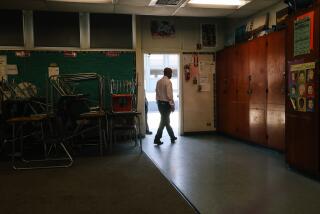Backers of Breakup Concede Legislative Foes Have the Edge
WOODLAND HILLS — With only 10 working days to go before the end of the 1993 legislative session, two state senators conceded at a town meeting Saturday that the movement to split up the Los Angeles Unified School District faces virtually insurmountable opposition in the Legislature.
“We’re facing an uphill battle,” Sen. David A. Roberti (D-Van Nuys) said. “It’s going to be tough, no doubt, no doubt. It’s harder to break up the school district than just about anything else. But there’s always next year.”
“If the legislation proves to be gridlocked, which is a reasonable assumption, the next step is a statewide initiative,” which requires the signatures of more than 300,000 voters to place it on the ballot, Sen. Tom Hayden (D-Santa Monica) said. “I think it would pass, but I think it would be a long, brutal and taxing fight.”
Roberti, who has led the movement but is being forced out of office next year because of term limits, pledged his continued support of the breakup to an audience of 100 supporters and opponents at Woodland Hills School.
“I’m not going to give up, whatever I am,” Roberti said in an interview after the meeting, referring to his possible bid for state treasurer or other political office.
Hayden called the meeting to update residents on the status of efforts to dismantle the 640,000-student district.
Supporters, including San Fernando Valley business groups, view smaller districts as boosting community control of education and providing a better classroom setting for learning. But opponents, including United Teachers-Los Angeles and Assembly Speaker Willie Brown (D-San Francisco), see the proposal as a way of stripping the ethnically diverse school board of power over education decisions in Los Angeles and dividing schooling along racial lines.
A bill by Roberti that would have established a commission to put a breakup plan before voters passed the Senate last month, but was killed in the Assembly Education Committee--partly because of what observers believe was Brown’s influence.
Last week, Roberti said he would revive the proposal by inserting its provisions into another bill on the Senate floor and try to send it directly to the Assembly floor, bypassing the Assembly Education Committee.
Another bill, sponsored by Assemblywoman Paula L. Boland (R-Granada Hills), would reduce from 400,000 to 160,000 the number of valid petition signatures of registered voters needed to move the issue to the state Board of Education, which would have the authority to put a breakup plan before Los Angeles voters.
The state board is regarded as sympathetic to the split because its members were appointed by Republican Gov. Pete Wilson and his GOP predecessor, George Deukmejian, but there is no guarantee that the panel would allow voters to decide the issue.
Last week, the Boland bill was approved by the Senate Education Committee and moved on to the Senate Appropriations Committee.
Several residents who spoke at Saturday’s meeting expressed impatience with the slow pace of the breakup, which had long been on the legislative back burner for years until Roberti won a Valley Senate seat last year.
“I consider moving here the biggest mistake I ever made in my child’s life,” said John Boystun, whose 7-year-old attends Woodlands Hills School. “This child is not going to junior high school here if I have to sell my house and live in my car.”
Some parents said they will vote Nov. 2 for a statewide ballot initiative that would provide parents with state-funded vouchers to help pay tuition for private and parochial schools.
But others, including Los Angeles school board member Mark Slavkin, urged residents to give site-based management and other reform plans a chance to work.
More to Read
Sign up for Essential California
The most important California stories and recommendations in your inbox every morning.
You may occasionally receive promotional content from the Los Angeles Times.










